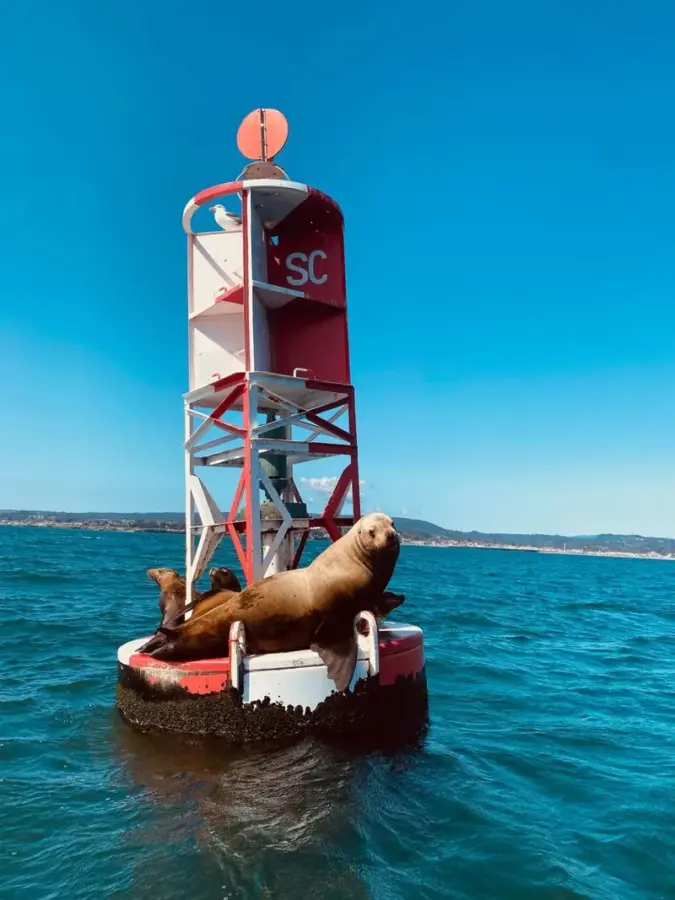
Santa Cruz Mile Buoy Saved by Alert Mariners
On March 18 we shared news that the USCG was proposing to remove the Mile Buoy “SC” about 1.5 miles SSW of Santa Cruz. Their plan was to replace it with a mark on the chart. Meaning there would no longer be any buoy or other permanent marker in the waters along the Santa Cruz coastline. Thankfully, the idea was put out for public comment before action was taken. The USCG wrote that it was “particularly interested in any rationale relating to why the buoy is necessary for safe navigation in spite of the current availability and affordability of electronic navigation equipment (e.g. GPS).”

Well, they asked, and readers answered.
We received comments from readers, some of whom said they were forwarding their response to the USCG.
“Years ago those buoy maintainers wanted to remove the Morro Bay sea buoy. A letter came into the local Aids to Navigation office saying how in foggy conditions they’d use their depth sounder to find the sixty fathom line then stay on that line until they heard the sea buoy’s gong. This was before buoys beeped. Once at the buoy they could find their way into Morro Bay. I heard the same story from my dad who sailed aboard a Jeep carrier in WWII.
“Additionally the buoy by putting Santa Cruz on the chart –so to speak– is a source of civic pride for the locals.” — John Dukat.
“Definitely retain -all- the buoys — a definite no to -all- the proposed changes! As you so correctly pointed out – electronics can and do fail!
I sail often with the latest gear on boats and have had my share of outages. It is telling that the Navy/CG itself is restoring CelNav — with GPS so vulnerable to solar storms and all the worldwide goings-on!
“Keep all the buoys and functionality! I just called the 510-437-2983 number and no voicemail – nothing, it is inoperative itself — irony there, they don’t even take messages.” — vkapur-1590.
“[V]virtual buoys do not show up on radar, and I have found the boat’s radar to be more stable than the GPS-enabled devices we have onboard. I sent an Email to the USCG with these comments.” — James McCann, Amateur NorCal Coastal Sailor.
“Add to the list of buoys offline, the Bodega Bay buoy, with its weather and sea state info for us north coasters, and the 2M buoy, south of the main shipping channel into S.F. Bay. The 2M was super helpful to keep Mariners who were approaching from the south, off the south bar. I am aware that the Trump administration gutted the budgets of the Coast Guard and Park Service, but all … these buoys save lives, which is the sworn service of the Coast Guard.” — Milly Biller.
And there are more! All contributed to the end result, with the Coast Guard issuing a statement on Friday. “Through the collaborative efforts of stakeholders and the positive engagement from the Santa Cruz maritime community, the Coast Guard made the decision not to remove the Santa Cruz Lighted Buoy SC (LLNR 4080).”
“The Coast Guard extends its sincere appreciation to the maritime community of Santa Cruz for their active participation in the formal process concerning navigation safety decisions,” said Capt. Steven Ramassini, chief, Coast Guard Office of Navigation Systems. “The invaluable feedback provided by the community has greatly contributed to our comprehensive understanding of the impacts associated with our proposed action.”
The good news was shared in the Santa Cruz Sentinal, which wrote that “local mariners, community members and elected officials voiced their concerns about the proposed replacement of the physical beacon with a virtual one.” The Sentinal also refers to an earlier attempt to remove the buoy in 2013, which was also met with public disapproval.
We’re grateful to everyone who spoke up and sent their comments in to help save this very useful and iconic buoy, then, and now.
“… What if our electrical grid shuts down, will they still be able to operate … like that?” Latitude reader Tasha wrote.”My grandfather before he passed used to use the light on the buoy and line [it] up with the bridges’ lights and that was how he knew to navigate into the harbor; this would be devastating to remove for our fishing community.”
“I cannot imagine a still Sunday morning without that iconic sound reminding me of the long ocean swell rolling through,” Karl Robrock commented.
Saving the buoy was a great example of people speaking up for what they believe. Thanks to the combined efforts, and the fact the USCG seeks public comment in the first place, this visual and audible signal will continue to be available to racers, cruisers, fishermen and kayakers who count on it when electronics fail.
Next time you round Mile Buoy take a photo and share it with your Latitude family by uploading it here: Latitude 38 Sailagram.
If you want to know more about the future of our traditional buoys and navigational marks, look out for Tim Henry’s follow up story in ‘Lectronic Latitude.

I am very glad to hear this, and also glad to hear the responsiveness of the Coast Guard on the situation.
I’m not so young that I can remember needing to use these buoys and a depthsounder to navigate in the MORC ocean races, as our simple boat had no radar or LORAN on board. We did many Windjammer’s races to SC and that mile buoy was a welcome sight!